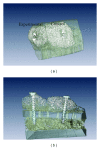Bone-Forming Capabilities of a Newly Developed NanoHA Composite Alloplast Infused with Collagen: A Pilot Study in the Sheep Mandible
- PMID: 24285956
- PMCID: PMC3826298
- DOI: 10.1155/2013/296391
Bone-Forming Capabilities of a Newly Developed NanoHA Composite Alloplast Infused with Collagen: A Pilot Study in the Sheep Mandible
Abstract
Lateral or vertical bone augmentation has always been a challenge, since the site is exposed to constant pressure from the soft tissue, and blood supply only exists from the donor site. Although, for such clinical cases, onlay grafting with autogenous bone is commonly selected, the invasiveness of the secondary surgical site and the relatively fast resorption rate have been reported as a drawback, which motivated the investigation of alternative approaches. This study evaluated the bone-forming capability of a novel nanoHA alloplast infused with collagen graft material made from biodegradable polylactic acid/polyglycolic acid versus a control graft material with the same synthesized alloplast without the nanoHA component and collagen infiltration. The status of newly formed bone and the resorption of the graft material were evaluated at 6 weeks in vivo histologically and three dimensionally by means of 3D microcomputed tomography. The histologic observation showed that newly formed bone ingrowth and internal resorption of the block were observed for the experimental blocks, whereas for the control blocks less bone ingrowth occurred along with lower resorption rate of the block material. The three-dimensional observation indicated that the experimental block maintained the external geometry, but at the same time successfully altered the graft material into bone. It is suggested that the combination of numerous factors contributed to the bone ingrowth and the novel development could be an alternative bone grafting choice.
Figures




References
-
- Wallace S, Gellin R. Clinical evaluation of freeze-dried cancellous block allografts for ridge augmentation and implant placement in the maxilla. Implant Dentistry. 2010;19(4):272–279. - PubMed
-
- Hof M, Pommer B, Strbac GD, Sütö D, Watzek G, Zechner W. Esthetic evaluation of single-tooth implants in the anterior maxilla following autologous bone augmentation. Clinical Oral Implants Research. 2011;24(supplement 100):88–93. - PubMed
-
- Henry PJ, Laney WR, Jemt T, et al. Osseointegrated implants for single-tooth replacement: a prospective 5-year multicenter study. The International Journal of Oral & Maxillofacial Implants. 1996;11(4):450–455. - PubMed
-
- Sánchez AR, Sheridan PJ, Eckert SE, Weaver AL. Influence of platelet-rich plasma added to xenogeneic bone grafts in periimplant defects: a vital fluorescence study in dogs. Clinical Implant Dentistry and Related Research. 2005;7(2):61–69. - PubMed
-
- Simion M, Trisi P, Piattelli A. GBR with an e-PTFE membrane associated with DFDBA: histologic and histochemical analysis in a human implant retrieved after 4 years of loading. The International Journal of Periodontics & Restorative Dentistry. 1996;16(4):338–347. - PubMed
LinkOut - more resources
Full Text Sources
Other Literature Sources

